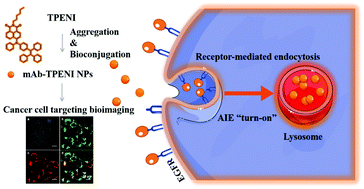A brightly red emissive AIEgen and its antibody conjugated nanoparticles for cancer cell targeting imaging†
Abstract
Antibody decorated nanoparticles with brightly red emissions are promising probes for targeted detection of cancer cells due to their excellent specificity, deep penetration depth, high photostability and low phototoxicity. Nevertheless, traditional fluorophores with planar structures and a strong donor–acceptor (D–A) effect are not ideal candidates for preparing the targeting nanoprobes since the aggregation of these fluorophores may cause the quenching of the emission due to the strong intermolecular interactions. Herein, a new red emissive luminogen with aggregation-induced emission property has been designed and synthesized. The new AIE luminogen with a conjugated D–A structure not only avoids the quenching of fluorescence but also shows enhanced photostability and remarkable two-photon absorption in its nanoaggregates. Encapsulated by biocompatible DSPE-PEG2000 and DSPE-PEG2000-COOH, these AIE nanoparticles can be conjugated with antibody cetuximab with targeting specificity to the epidermal growth factor receptor (EGFR), which is generally overexpressed in non-small lung cancer cells. These AIEgen nanoparticles provide an ideal architecture for cancer cell-specific fluorescence imaging and detection with bright red emission, high photostability, and good specificity.

- This article is part of the themed collections: FOCUS: Recent progress on bioimaging technologies and FOCUS: Recent progress on aggregation-induced emission


 Please wait while we load your content...
Please wait while we load your content...